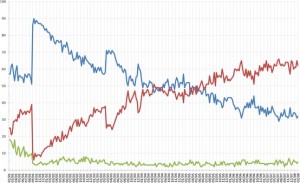Did you know that sunburns cause shark bites!? Or that a full moon increases a batter’s chance to hit a home run? Or that people with larger shoe sizes have larger vocabularies?
Before you pull your own shoe off and beat it on the conference table, yes we’re kidding. So what are we looking at here, and why is it important regarding market research and statistical analysis?
The correlating facts buried in these outlandish statements are that statistics show that there are more shark bites reported when the numbers of sunburns are up. Similarly, statistically, there are more home runs hit during a full moon, and the vocabulary thing, yes, it’s true. But these are correlations, not causations. Coincidences, if you will, or states of being.
And though there is no causal relationship, it’s very easy to misrepresent multiple pieces of data and communicate them as causations. But just because these things happen at the same time does not mean that one causes the other.
Correlation really means two variables are behaving similarly or in unison, like home runs and baseball. Causation is when one variable is dependent on the other — dieting and exercise leading to weight loss — which is incredibly difficult to prove. Correlations are everywhere around us all the time; causations are few and far between.
You can theorize about causations all day and stretch correlations to their breaking points (and many people do publicly, from advertising to political opponents to those in medical field), but no matter how closely correlated two things are, they will not “achieve” causation without testing and scrutiny, and even then, events and facts are like spokes on a wheel. Often there are many factors of causation, not merely one-to-one.
So to further vet these statements to illustrate how correlations can be misunderstood, let’s go back to our shark bites example. This one is pretty easy to figure out: it’s probably summer. More people are at beaches, so lots of sunburning is going on, and likewise, more people are where sharks live. Then, the full moon home runs is a coincidence, nothing more.
Lastly, put your shoe back on because this didn’t say that this observation is about all men and women between 35 and 55. What if we compare the vocabulary of a third grader with a size 5, compared to you at a size 10. Obviously you’re going to have the better vocabulary.
And now you can add correlation and causation to it.





